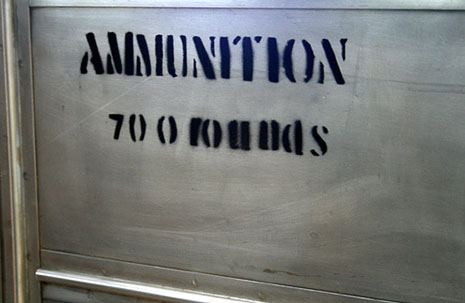IN BERNARD SHAW’s comedy, Arms and the Man, the Swiss mercenary Bluntschli cheerfully admits to carrying chocolate creams in his ammunition pouch when he goes to war. Sweets, he said, were much more useful than bullets on the battlefield. But what was funny on the London stage in 1895 is no joke in modern military operations. Reliable and adequate supplies of serviceable ammunition are an obvious and basic necessity for successful defence force operations. Battles are not won with chocolate creams.
With the Australian Defence Force engaged in increasingly lethal operations in Afghanistan, a scathing new report from the auditor-general has cast serious doubt on the ability of Defence to reliably manage and supply the bullets, bombs, warheads and other items in the ADF’s lethal weapons inventory. The little-noticed report last month revealed that at 30 June last year Defence’s total stock holdings of explosive ordnance inventory were valued at $2.9 billion with some 42 per cent categorized as “other than serviceable.” At the same time the value of army ordnance categorised as other than serviceable was 57 per cent of stock valued at $437.7 million.
In other words, nearly half of the ADF’s ordnance stocks and nearly 60 per cent of the army’s stocks cannot be fired in anger. They might as well be chocolate creams. The auditor’s figures suggest a potential crisis in ADF munitions management – especially as the report is the sixth since 1987 to criticise aspects of munitions management.
With characteristic understatement the Australian National Audit Office concluded that the figures for “other than serviceable” munitions suggested that there had been only limited improvement in explosive ordnance management. Arrangements tended to be “fragmented” and there were major skills shortages. The report said that the munitions branch of explosive ordnance division was using an inventory management tool with “known deficiencies” and concluded that the issues required “the effective implementation of long-term remediation strategies.”
Despite the report’s implications for the ability of the ADF to sustain high-intensity combat operations, there has been little political or departmental response to the report to date. Political and departmental inclinations seem to be to sweep the issue aside.
Defence and the Defence Materiel Organisation, or DMO, readily agreed to the auditor’s recommendations that they develop processes for consolidating inventory requirements at an appropriate level and undertake a strategic review of domestic ammunitions manufacturing arrangements to ensure value for money and the viability of ongoing investment in domestic capacities. Unfortunately, as the report details, previous agreements to improve the supply and serviceability of munitions have often not been implemented or implemented only partly. So it seems relevant to examine responsibility for munitions management and to look at the costs of current domestic manufacturing arrangements.
Two years ago the vice chief of the defence force was put in charge of explosive ordnance and the explosive ordnance branch in Logistics Command was established to oversee ordnance and weapons security.
The DMO is responsible for procurement, sustainment and through-life support of explosive ordnance and for ensuring that inventory is held at appropriate levels of serviceability. According to the auditor, DMO’s ordnance sustainment budget is some $400 million annually.
The primary local supplier of munitions is Thales Australia (formerly ADI). Under the so-called SAMS agreement with Defence, Thales Australia is required to maintain the capability to manufacture some thirteen of approximately 830 ordnance items required by the ADF. It does so from a factory near Benalla in Victoria.
According to the Audit Office, Defence spends $20 million a year on SAMS items and is required to pay Thales $63.2 million a year (indexed annually) to retain its manufacturing capability. Under a separate agreement Thales operates a Defence-owned propellant and high explosive production factory at Mulwala in southern New South Wales. Mulwala supplies Bendigo and Defence pays another $29.7 million (indexed annually) to retain agreed production capability at Mulwala.
The auditor notes that the SAMS and Mulwala agreements will expire in 2015, but that DMO will continue to spend significantly on the agreements and on redeveloping the Muwala facility at a cost of $31 million. Urging a strategic review of the arrangements, the auditor notes “uncertainty within Defence surrounding the form of future domestic manufacturing arrangements for explosive ordnance.”
There are good reasons why Defence is prepared to pay a premium for guaranteed local military ammunition production. But continuing high levels of “other than serviceable” military ammunition stocks, and the costs of paying Thales Australia to keep the factories running, are raising questions about whether the current arrangements are delivering value for money. Domestic manufacturing arrangements for explosive ordnance currently represent an area of significant expenditure that needs to be more strategically managed”, the auditor says.
Notwithstanding Bluntschli’s cynical realism no modern defence force can afford an army of chocolate cream soldiers. The ADF’s ammunition problems require urgent attention. •




